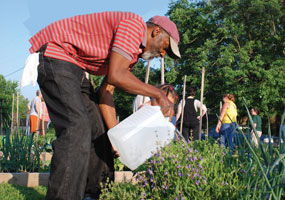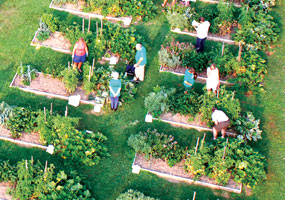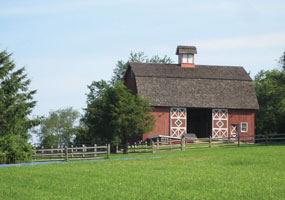The Growing Fresh Food Movement

In Spring 2010, renowned British chef Jamie Oliver exposed millions of Americans to the poor eating habits and weight-related illnesses in Huntington, West Virginia, which has the unfortunate distinction of being one of the unhealthiest cities in America. In his show Food Revolution on ABC, viewers watched as families ate only beige foods, school-aged children failed to identify fresh produce and kids opted to eat chicken nuggets over fresh-made food.
Beyond the reality-show shock value, Oliver presented the obstacles to healthy eating inherent in the American food system, including social and political opposition, the limitations of school lunch programs and the financial constraints of U.S. families. Oliver is not alone in his quest—and enthusiasm—to transform the national food agenda. Individuals and grassroots organizations in rural and urban areas are on a mission to provide good food to people of all ages and socioeconomic backgrounds.
Farm Fresh, at School
Hunger relief organization Feeding America found in its “Hunger in America 2010” study that more than 37 million people, or one in eight Americans, including 14 million children, are fed by food banks each year. This grew an estimated 46% from the organization’s 2006 findings, largely due to the economic downturn. But, school-aged children and their families rely on other forms of government aid to supplement their basic nutritional needs.The National School Lunch Program (NSLP), a federally assisted meal program that provides nutritionally balanced, low-cost or free lunches to public schools, has also had to respond to increased demand. In 2004, 29 million children utilized NSLP; in 2009, more than 31 million children relied on the program each school day.

School lunches got a boost this past November with the passage of The Healthy, Hunger-Free Kids Act, which will provide more meals and set healthier nutrition standards in schools. But it is not without its costs.
“In many places, food service is a separate entity and not part of the school budget,” says Marion Kalb, codirector of the National Farm to School Network. “It has its own complete budget, and they’re required to pay, for example, for rent, for heating and for electric.”
In recent years, farm-to-school programs have become options for thousands of school districts and food service programs that want to integrate fresh fruits and vegetables from local farms or from campus or community gardens into their menus.
One notable farm-to-school initiative is the Edible Schoolyard (ESY), established by acclaimed chef and local food advocate Alice Waters and her Chez Panisse Foundation. The ESY is a one-acre organic garden and kitchen classroom at Martin Luther King Middle School in Berkeley, California, where, since 1996, more than 3,000 students have participated in the farm-related multidisciplinary curriculum.“I think the ESY is so successful because we integrate the curriculum of the school into kitchen-and-garden classes, and then confirm that with a healthful school lunch,” says David Prior, director of communications for the foundation.Even as school districts try to integrate farm-to-school meal programs, healthy food options at home can remain elusive for families. That’s why a growing number of community gardens and farms have sprouted, such as Wilmington College’s Grow Food, Grow Hope project in Ohio.

In 2008, the package delivery corporation DHL closed shop, devastating residents of Clinton County, Ohio. More than 8,000 jobs were lost and unemployment rates skyrocketed to 18%. Rooted in the success of WWII victory gardens, the Grow Food, Grow Hope initiative provides 40 community garden plots on the Wilmington College campus to low-income individuals. Families have access to produce during the growing season as well as opportunities to learn about sustainable growing methods.
Grow Food, Grow Hope boasts an extensive list of projects that promote food access, including numerous food gardens throughout the county, demonstration gardens, well-attended youth programs and camps, a successful farmers’ market and the donation of thousands of pounds of produce to various food pantries and banks.
“We have had incredible collaborations develop throughout our community to both assist our program and to be assisted by our program,” says Katrina Frazee, the AmeriCorps VISTA supervisor at Grow Food, Grow Hope.
A Return to Farming Roots
In addition to economic necessity, returning to a town’s agricultural past strngthens the community. Ambler Farm is an 18-acre community-owned teaching operation in Wilton, Connecticut, that utilizes land once belonging to a 200-acre family farm. It’s home to a large food garden that produces fresh vegetables for a local farmers’ market, an on-site farm stand, an apiary, several farm animals, including rabbits, chickens, goats and sheep, and historical barns.
The farm boasts more than 5,000 visitors per year through its youth summer programs, apprenticeships, adult programs, farm stand and sugar shack, open houses and town events.
“We think the farm represents how this community has evolved,” says Ann Bell, president of the Friends of Ambler Farm. “The gardens, farm-to-table [initiatives] and the connection to schoolchildren has been a rallying point for the community.”
Farmer Leaf Myczak, cocreator of Broadened Horizons Organic Farm, a teaching farm in Rockwood, Tennessee, emphasizes the importance of self-reliance, self-sufficiency and having a physical connection to the land and one’s food.
“We are demonstrating a lifestyle of voluntary simplicity,” says Myczak. “I think when people eat, they remember that day on the farm and the community that was gathered to work together. We’re trying to duplicate the old farming community, where people got together on workdays.”
CONTACTS: Ambler Farm; Broadened Horizons Organic Farm; Grow Hope.

